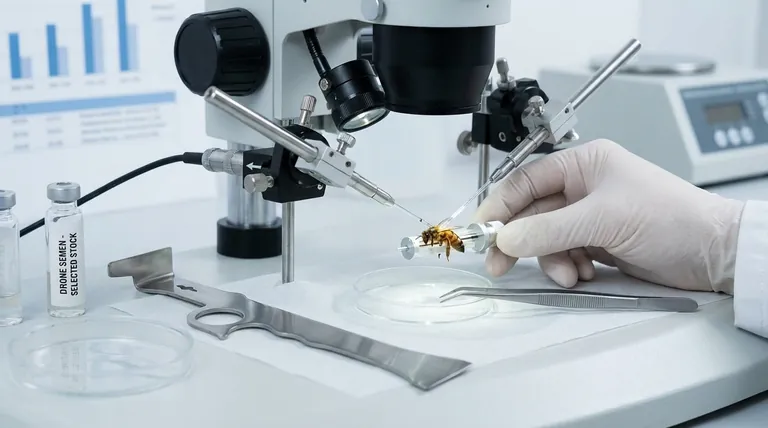The primary advantage of instrumental insemination is the absolute control it gives a breeder over honey bee genetics. Unlike open mating where queens mate with numerous, unknown drones, this technique allows for precise, pre-determined pairings. This control is the key to creating specific crosses, amplifying desirable traits, and accelerating the development of bee stocks with targeted characteristics, such as disease resistance.
Instrumental insemination removes the genetic randomness of natural mating. It transforms bee breeding from a game of chance into a deliberate, scientific process for engineering specific and predictable outcomes.

Why Precise Genetic Control Matters
In natural mating, a virgin queen embarks on mating flights and mates with 10-20 different drones from the surrounding area. The genetics of these drones are unknown. Instrumental insemination bypasses this uncertainty entirely.
The Foundation of the Technique
The process involves collecting semen from specific, selected drones into a capillary tube using specialized equipment. This semen is then carefully injected directly into the oviducts of an anesthetized virgin queen.
This gives the breeder complete control over both sides of the genetic equation: the queen (dam) and the drones (sires).
Ensuring a Well-Mated Queen
Breeders can control the exact volume of semen a queen receives, ensuring she is well-mated and capable of laying fertilized eggs for her entire productive life. Modern techniques result in inseminated queens that perform on par with their naturally mated counterparts in terms of egg-laying.
Strategic Breeding Outcomes
This level of control unlocks several powerful breeding strategies that are impossible to achieve with natural mating.
Creating Novel Genetic Crosses
Breeders can create very specific crosses between different lines of bees that would never occur in nature. This is essential for combining valuable traits, such as hygienic behavior from one line and honey production from another.
Amplifying Elite Drone Genetics
If a single drone displays exceptional traits, his genetics can be amplified significantly. His semen can be used to inseminate multiple queens, rapidly propagating his valuable genes throughout a breeding program.
Homogenizing Semen for Consistency
Semen from hundreds of selected drones can be collected and mixed together. This homogenized semen is then used to inseminate an entire batch of sister queens, producing colonies with highly consistent and predictable genetic traits.
Accelerating Trait Selection
Instrumental insemination is a powerful tool for improving stocks against specific threats. For example, it is critical for developing bees with Varroa Sensitive Hygiene (VSH), a behavioral trait that helps colonies combat devastating Varroa mites.
Understanding the Realities and Requirements
While powerful, instrumental insemination is not a simple solution. It is a sophisticated technique with a significant learning curve.
A Tool for Experts
Effective use requires a solid foundation in bee biology and the principles of genetic selection. The procedure itself is delicate and requires extensive practice and specialized microscopic equipment to master.
Not a Replacement for Good Beekeeping
Instrumental insemination is a tool within a larger breeding program. It does not replace the need for good apiary management, careful record-keeping, and rigorous selection of the best breeding stock. Its success depends entirely on the quality of the genetics being used.
Applying This to Your Breeding Goals
Instrumental insemination is the correct tool when your breeding program requires a level of genetic precision that open mating cannot provide.
- If your primary focus is trait acceleration: Use insemination to create specific crosses that concentrate desirable genes, such as for VSH or other hygienic behaviors.
- If your primary focus is creating a new, stable line: Use homogenized semen from a wide pool of desirable drones to ensure genetic diversity and consistency across a new line of queens.
- If your primary focus is research or stock maintenance: Use single-drone inseminations to maintain pure genetic lines and study the precise impact of specific genes.
Ultimately, instrumental insemination empowers you to take direct control over the genetic destiny of your honey bees.
Summary Table:
| Advantage | Key Benefit |
|---|---|
| Precise Genetic Control | Eliminates the randomness of natural mating; allows for specific, pre-determined pairings. |
| Trait Acceleration | Enables rapid propagation of desirable traits like Varroa Sensitive Hygiene (VSH) and hygienic behavior. |
| Creation of Novel Crosses | Combines valuable traits from different bee lines that would not occur naturally. |
| Genetic Consistency | Using homogenized semen produces colonies with highly predictable and uniform traits. |
Ready to elevate your breeding program with professional-grade tools?
Instrumental insemination requires precision equipment to be successful. HONESTBEE supplies commercial apiaries and beekeeping equipment distributors with the high-quality, reliable supplies needed to implement these advanced techniques effectively.
Contact our expert team today to discuss how our wholesale-focused operations can support your genetic improvement goals with the right equipment.
Visual Guide

Related Products
- HONESTBEE Advanced Ergonomic Stainless Steel Hive Tool for Beekeeping
- Plastic Chinese Queen Grafting Tool for Bee Queen Rearing
- No Grafting Queen Rearing Kit: System for Royal Jelly Production and Queen Rearing
- Professional Dual-End Stainless Steel Hive Tool for Beekeeping
- Professional 3-Bar Frame Grip with Integrated Hive Tool
People Also Ask
- What tools are used for cleaning frames? A Beekeeper's Simple 4-Tool Guide
- What are the features of a regular hive tool? The Essential Multi-Tool for Every Beekeeper
- What are some common uses of a hive tool? Essential Multi-Purpose Tool for Every Beekeeper
- What is a hive tool and what are its uses? Master Your Hive Inspections with the Essential Beekeeper's Tool
- Why do hive tools have a hole? Unlock the Secret to Efficient Beekeeping



















